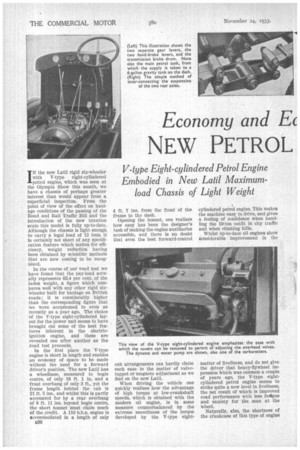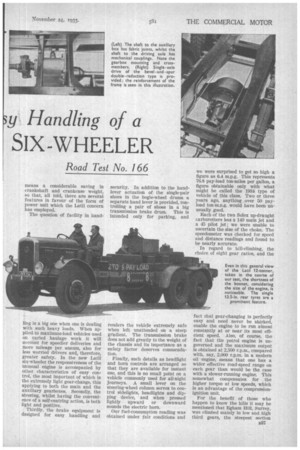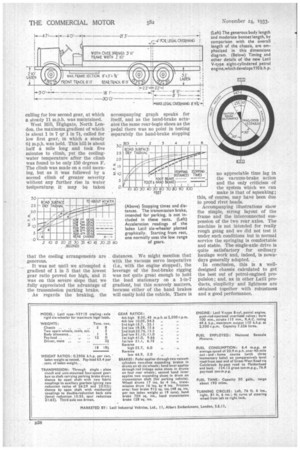Economy and Ec y Handling of a
Page 46

Page 47

Page 48

If you've noticed an error in this article please click here to report it so we can fix it.
NEW PETROL
SIX -WHEELER
V-type EightcylinderedPetrol Engine Embodied in New Laid Maximum load Chassis of Light Weight Road Test No. 166
IN the new Latil rigid six-wheeler with V-type eight-cylindered petrol engine, which was seen at the Olympia Show this month, we have a chassis of perhaps greater interest than would appear from a superficial inspection. From the point of view of the effect on haulage conditions of the passing of the Road and Rail Traffic Bill and the introduction of the new taxation scale this model is fully up-to-date. Although the chassis is light enough to carry a legal load of 12 tons, it Is certainly not short of any specification feature which makes for efficiency, weight reduction having been obtained by scientific methods that are now coming to be recognized.
In the course of our road test we have found that the pay-load actually represents 63.4 per cent. of the laden weight, a figure which compares well with any other rigid sixwheeler built for haulage on British roads ; it is considerably higher than the corresponding figure that we were accustomed to even as recently as a year ago. The choice of the V-type eight-eylindered layout for the power unit seems to have brought out some of the best features inherent in the electricignition engine, and these are revealed one after another as the road test proceeds.
In the first place the V-type engine is short in length and enables an economy of space to be made without the need for a forward driver's position. The new Latil has a wheelbase, measured to bogie centre, of only 18 ft. 1 in. and a front overhang of only 3 ft., yet the frame length behind the cab is 21 ft. 5 ins., and whilst this is partly accounted for by a rear overhang of 8 ft. 11 ins, beyond bogie centre, the short bonnet must claim much of the credit. A 110 b.h.p. engine is accommodated in a length of only B36 4 ft. 7 ins, from the front of the fhtme to the dash.
Opening the bonnet, one realizes how easy has been the designer's task of making the engine auxiliaries accessible, and there is no doubt that even the best forward-control
cab arrangements can hardly claim such ease in the matter of valvetappet or magneto adjustment as we find on the new Latil.
When driving the vehicle one quickly realizes how the advantage of high torque at low-crankshaft speeds, which is obtained with the modern oil engine, is in some measure counterbalanced by the extreme smoothness of the torque developed by the V-type eight
cylindered petrol engine. This makes the machine easy to drive, and gives a feeling of confidence when handling the 19-ton outfit in city traffic and when climbing hills.
Whilst up-to-date oil engines show eonsiderable improvement in the
matter of liveliness, and do not give the driver that heavy-flywheel impression which was common a couple of years ago, the V-type eightcylindered petrol engine seems to strike quite a new level in liveliness, the net result of which is improved road performance with less faegue and anxiety for the man at the wheel.
Naturally, also, the shortness of the crankcase of this type of engine means a considerable saving in crankshaft and crankcase weight, so that, all told, there are several features in favour of the form of power unit which the Latil concern has employed.
The question of facility in hand ling is a big one when one is dealing with such heavy loads. When applied to maximum-load vehicles used on varied haulage work it will account for speedier deliveries and more mileage per annum, also for less worried drivers and, therefore, greater safety. In the new Latil six-wheeler the responsiveness of the unusual engine is accompanied by other characteristics of easy control, the most important of which is the extremely light gear-change, this applying to both the main and the auxiliary gearboxes. Secondly, the steering, whilst having the convenience of a self-centring action, is both light and positive.
Thirdly, the brake equipment is designed for easy handling and security. In addition to the handlever actuation of the single-pair shoes in the bogie-wheel drums a separate hand lever is provided, controlling a pair of shoes in a big transmission brake drum. This is intended only for parking, and renders the vehicle extremely safe when left unattended on a steep gradient. The transmission brake does not add greatly to the weight of the chassis and its importance as a safety factor deserves commendation.
Finally, such details as headlight and horn controls are arranged so that they are available for instant use, and this is no small point on a vehicle commonly used for all-night journeys. A small lever on the steering-wheel column serves to control sidelights, headlights and dipping device, and when pressed lightly upward or downward sounds the electric horn.
Our fuel-consumption reading was obtained under fair conditions and we were surprised to get so high a figure as 6.4 m.p.g. This represents 76.8 pay-load ton-miles per gallon, a figure obtainable only with what might be called the 1934 type of vehicle of this class. Two or three years ago, anything over 50 payload ton-m.p.g. would have been unusually good.
Each of the two Solex up-draught carburetters has a 140 main jet and a 45 pilot jet ; we were unable to ascertain the size of the choke. The speedometer was checked for speed and distance readings and found to be nearly accurate.
In regard to hill-climbing, time choice of eight gear ratios, and the fact that gear-changing Is perfectly easy and need never be shirked, enable the engine to be run almost constantly at or near its most efficient speed. Also, of course, the fact that the petrol engine is ungoverned and the maximum output is obtained at 2,500 r.p.ra., compared with, say, 2,000 r.p.m. in a modern oil engine, means that one has a wider effective road-speed range on each gear than would be the case with a slower-running engine. This somewhat compensates for the higher torque at low speeds, which is an advantage of the compressionignition unit.
For the benefit of those who happen to know the hilL1 it may be mentioned that Egharn Hill, Surrey, was climbed mainly in low and high third gears, the steepest section.
calling for low second gear, at which a steady 11 m.p.h. was maintained.
West Hill, Highgate, North London, the maximum gradient of which is about 1 in 7 qr 1 in 7, called for low first gear, in which a steady m.p,h. was held. This hill is about half a mile long and took five minutes to climb, yet the coolingwater temperature after the climb was found to be only 150 degrees F. The climb was made on a cold morning, but as it was followed by a second climb of greater severity without any further rise in water teniperaturet it may be taken
that the cooling arrangements are generous.
It was not until we attempted a gradient of 1 in 5 that the lowest gear ratio proved too high, and it was on this severe slope that we fully appreciated the advantage of the transmission parking brake.
As regards the braking, the
accompanying graph speaks for itself, and as the hand-brake actuates the same rear-bogie shoes as the pedal there was no point in testing separately the hand-brake stopping
distances. We might mention that with the vacuum servo inoperative (i.e., with the engine stopped), the leverage of the foot-brake rigging was not quite great enough to hold the load stationary on a 1-in-7 gradient, but this scarcely matters, because either of the hand brakes will easily hold the vehicle. There is no appreciable time lag in the vacuum-brake action and the only criticism of the system which we can make is that of squeaking; this, of course, may have been due to proud rivet heads.
Accompanying illustrations show the simple, strong layout of the frame and the interconnected suspension of the two rear axles. The machine is not intended for really rough going and we did not test it under such conditions but in normal service the springing is comfortable and stable. The single-axle drive is quite satisfactory for ordinary haulage work and, indeed, is nowadays generally adopted.
In conclusion, this is a welldesigned chassis calculated to get the best out of petrol-engined propulsion; and, as in other Latil products, simplicity and lightness are obtained together with robustness and a good performance.




















































































